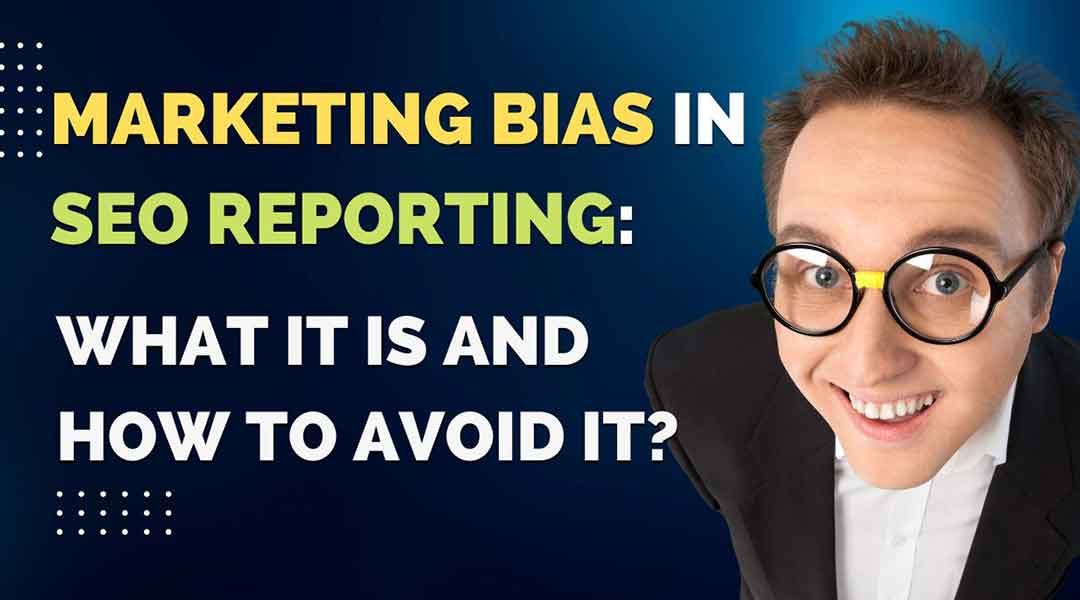As a business owner, you likely rely on data to decide where to focus your marketing efforts. This data comes from a variety of sources, including SEO reporting. However, it’s important to be aware that marketing bias can creep into even the most well-intentioned SEO reports.
What Is Marketing Bias in SEO reporting?
Marketing bias is any distortion of data that leads to inaccurate or misleading conclusions. This can happen either intentionally or unintentionally. In the context of SEO reporting, marketing bias can lead business owners to make the wrong decisions about where to allocate their marketing budgets.
There are a few different ways that marketing bias can enter into SEO reports:
- Omitting data that doesn’t fit the narrative.
- Presenting data in a way that is misleading or difficult to understand.
- Drawing conclusions that are not supported by the data.
But before we go ahead and discuss how to avoid marketing bias, let’s take a look at some of the common marketing biases that can enter into SEO reports and affect the decisions you make about your marketing strategy.
Common Marketing Biases
There are many types of marketing bias, but some are more common than others regarding SEO reporting. Here are a few of the most common biases to look out for:
1. Confirmation Bias
Confirmation bias is the tendency to focus on information that confirms your beliefs while ignoring information that contradicts those beliefs. This bias can lead business owners to cherry-pick data points that support their existing marketing strategy while ignoring data that indicates they should make a change.
For instance, let’s say you’re considering launching a new paid search campaign. You might be more likely to focus on the data that shows paid search is effective while ignoring data that indicates it might not be the best use of your marketing budget.
Confirmation bias can lead business owners astray. The best way to avoid this bias is to ensure you’re looking at all the data, not just the data supporting your preconceived notions.
2. Selection Bias
Selection bias occurs when the data you’re looking at is not representative of the population as a whole. This can happen in two ways:
- The data is self-selected. This happens when people choose which data to include in a report.For example, let’s say you’re looking at data from your website’s analytics. You might only look at the data for the pages that received the most traffic. It is important to note that this data is not representative of your entire website.Let’s say, for example, that you have a website with 100 pages. 60 of those pages receive very little traffic, but the other 40 pages receive a lot of traffic. If you only look at the data for the 40 pages that receive a lot of traffic, you’re not getting an accurate picture of your website as a whole.
- The data is selected for you. This happens when someone else chooses which data to include in a report.For example, your SEO agency might only include data that shows the progress they’ve made on your SEO campaign. But this data is not representative of your entire SEO strategy.To get a better understanding, let’s say your SEO campaign has three main goals: to improve your website’s ranking on Google; to increase the number of visitors to your website, and to improve the quality of your website’s content.Your SEO agency might only focus on the data that shows how your website’s ranking has improved. But if your website’s ranking has improved and you’re not seeing an increase in visitors or improvements in the quality of your content. In that case, that data is not representative of your overall SEO campaign.To avoid selection bias, ensure you’re looking at all the data, not just the data that someone else has selected for you.
3. Group Attribution Errors
Group attribution errors occur when you see the behavior of a single person and immediately attribute that person’s traits to the entire group. In reporting, this is often seen when business owners make assumptions about their target market.
For example, let’s say you’re trying to reach millennial women with your marketing. But you see one millennial woman who doesn’t respond to your marketing, so you assume that all millennial women are uninterested in your product. This would be an example of a group attribution error.
To avoid this bias, it’s important to remember that not everyone in a group is the same. Just because one person in a group behaves a certain way doesn’t mean everyone behaves that way. The best way to deal with this is to increase the sample size of your data so that you’re not just basing your conclusions on one person’s behavior.
4. Misconceptions and Misinterpretations
There are a lot of metrics out there, and it’s easy to get confused about what they all mean. This confusion can lead to misconceptions and misinterpretations.
For example, let’s say you’re looking at your website’s bounce rate. A high bounce rate might be interpreted as a bad thing, but that’s not always the case. A high bounce rate could simply mean that people find what they’re looking for on your website and then leave.
Misconceptions and misinterpretations can also occur when people confuse two similar metrics. For example, people often confuse website traffic with web page views. But these two things are not the same. Website traffic refers to the number of people who visit your website, while web page views refer to the number of times a page on your website is viewed.
This is very common with tools like Google Analytics. It is an easy to navigate tool, but various complexities might be confusing for people unfamiliar with it. It is advised that you seek an expert’s help if you are unsure about something.
Social media is yet another platform where people often make this mistake. Just because you see a high number of likes or followers doesn’t mean that a lot is seeing your content of people. It’s important to look at the reach of your content, which is the number of people who actually see it.
You can avoid misconceptions and misinterpretations by educating yourself on measuring metrics. Make sure you understand what each metric means and how it should be interpreted.
5. Comparison Errors
Comparison errors occur when you compare two things that are not actually comparable. This is often seen in reports where people compare apples to oranges.
For example, let’s say you’re looking at the number of leads you generated last month, and you compare it to the number of leads your competitor generated. But you don’t take into account the fact that your competitor has been in business for 10 years longer than you have. This would be an example of a comparison error.
To avoid this bias, you must ensure that you’re choosing the right metrics to compare. You also need to ensure that you’re taking into account all the relevant factors when making your comparisons.
6. Communication Errors
Communication errors occur when the way you communicate your findings is confusing or misleading. This often happens when people use jargon that their audience doesn’t understand.
For example, let’s say you’re using the term “CTR” in your report. But you don’t explain what CTR stands for or what it means. This would be an example of a communication error.
It is best to summarize the findings in layman’s terms so that anyone can understand them. Jargon should be avoided as much as possible or explained when used.
How Can You Avoid Marketing Bias in SEO Reports?
The best way to avoid marketing bias is to be aware of it. Once you know what to look for, you can avoid bias in your own reports.
Here are some tips to help you avoid marketing bias:
1. Be Aware of Your Own Biases
It’s important to be aware of your own personal biases. We all have them and they can often distort the way we see things. If you’re not aware of your biases, they can easily creep into your reports.
2. Choose the Right Metrics
When choosing the metrics to include in your report, make sure they’re relevant and meaningful. Avoid metrics that could be misinterpreted or that are not comparable.
3. Educate Yourself on the Metrics
Make sure you understand what each metric means and how it should be interpreted. This will help you avoid communication errors.
4. Use Data Visualizations
Data visualizations can help make your data more understandable and easier to interpret. They can also help highlight trends and patterns that might otherwise be missed.
5. Get Feedback From Others
When creating your reports, getting feedback from others is a good idea. This can help you catch any errors or biases you might have missed.
By following these tips, you can avoid marketing bias in your SEO reports. You can help your clients make better decisions about their SEO campaigns by providing accurate and unbiased reports.
How A White Label SEO Company Can Help
If you’re not sure how to avoid marketing bias in your reports, a white-label SEO company can help. They can provide accurate and unbiased reports to help your clients make better decisions about their SEO campaigns.
A white label SEO company can also help you choose the right metrics, data visualizations, and feedback. Check out our white label SEO services to learn more about how we can help you with your SEO reporting.











2 comments
Edna Casey
October 28, 2022 at 12:22 pm
A great guide to avoid marketing bias in SEO reporting. Keep writing concise and informative articles.
Stephen Henry
November 27, 2022 at 11:47 am
That is exactly my point. This can lead to inaccurate data and results in poor decision making.
Comments are closed.